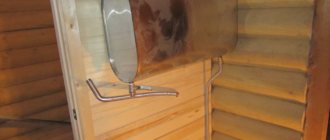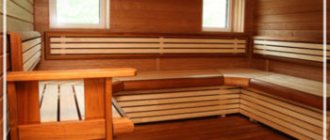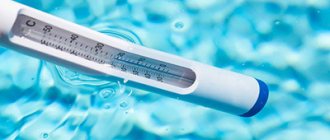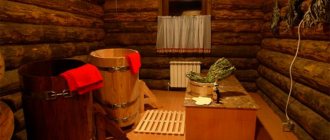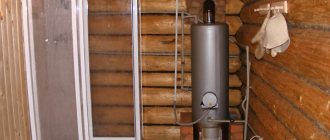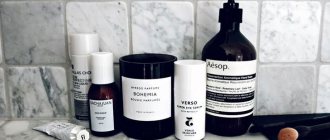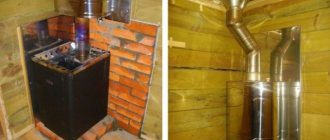There are mainly three ways to install a tank. The first is inside the stove, the second is away from it, and the third method is on the chimney pipe. Instead of the first installation method, we recommend installing the tank above the stove. This option of installing a water tank in a bathhouse is considered simpler, and besides, this method is suitable for those who already have a stove built.
ATTENTION! This replacement is only suitable if your chimney can be disassembled. This method requires a joint installation of the tank, i.e. it is placed simultaneously above the stones and around the chimney pipe, thereby increasing the efficiency of water heating. Otherwise, you will have to choose a built-in type of tank when building a stove, or install it at a certain distance from the stove.
In sauna stoves made of metal, the water tank should be attached above the heating chamber. Since the heating of the container occurs due to the force of the fire, as a result the water quickly heats up.
ATTENTION! If you have chosen a built-in tank design, then it is recommended to make it from metal, the thickness of which is at least 1 mm. It is also important to maintain the quality of the welds. Otherwise, the tank may quickly burn out or begin to leak due to poor-quality welds.
Why is there a tank in the bathhouse?
First, let's figure out why a tank is needed in a bathhouse. After all, just a couple of decades ago it was possible to do without it in a bathhouse, using buckets of water or a barrel. In fact, a tank in a bathhouse is a convenience. Now there is no need to heat water separately, you don’t have to worry that there won’t be enough water. It turns out that the tank is a version of the boiler, which always contains water at the required temperature. Almost all modern sauna stoves are equipped with tanks. If you buy a new furnace, it will most likely come with a tank included. If you have a stove in your bathhouse without a tank, you can easily choose a suitable tank. Many manufacturers of sauna equipment offer tanks separately from stoves, which significantly expands the possibilities for sauna lovers.
How to cover a water heating tank (inside)
So I wrote to Baltic Paints St. Petersburg, the guys responded quite quickly:
Unfortunately, we sell Temaline EPL only in industrial packaging; for painting the tank, I can offer you TsVES 2, if you have the opportunity to prepare the surface for painting. Min. packaging CVES 2 1.5 kg, cost 370.18 rub.
Anti-corrosion protection of steel TsVES anti-corrosion composition (TU 2312-004-12288779-99) Brief description
The composition of the TsVES brand is a two-pack anti-corrosion composition based on an ethyl silicate binder and highly dispersed zinc powder. The composition is produced in 2 brands, which differ in the mass ratio of ethyl silicate binder (component A) and zinc powder (component B).
Composition grade Mass fraction of ethyl silicate binder, % Mass fraction of highly dispersed zinc powder, % TsVES No. 1 50 50 TsVES No. 2 40 60
Purpose and areas of application
The composition of the TsVES brand is used: • as an independent coating; • as a primer for coating materials in complex protection systems; • for repair of zinc metal coatings. The composition is intended for corrosion protection of steel products and structures operated: • in atmospheric conditions of all macroclimatic regions, types and categories of location according to GOST 15150 69; • in sea and fresh water, aqueous solutions of salts (pH = 6.0-9.0); • in the practice of cold and hot domestic and drinking water supply, including drinking water; • in oil and petroleum products. Welding over a single-layer CVES coating does not degrade the quality of the weld. The coating is anodic to steel and provides its cathodic protection. Unstable in alcohols and a number of organic solvents.
Main technical characteristics Name of indicator Indicator value for brand TsVES No. 1 TsVES No. 2 Composition Appearance after thorough mixing Homogeneous suspension of gray color Homogeneous suspension of gray color Density, g/cm3 1.40-1.60 1.70-1.90 Conditional viscosity according to a VZ-246 viscometer with a nozzle diameter of 4 mm at a temperature of (200.5)°C, s 18-35 18-35 Pot life, hours, not less than 8 8 Drying time to degree 3 at a temperature of (202)° C, min, no more than 30 30 Theoretical consumption for a single-layer dry coating, g/m2 130-200 170-230 Coating Color and appearance Gray, matte Gray, matte Mass fraction of zinc in dry coating, % 89-91 92-94 Thickness one dry layer, µm 20-30 30-40 Adhesion to metal, score 1 1 Elasticity in bending, mm, no more than 3 5 Heat resistance in open air, С, no more Long-term short-term 150 200 150 200
Application technology
The composition of the TsVES brand is applied in factory and field conditions at temperatures from minus 15 to plus 40 ° C and relative air humidity from 30 to 80% (optimally no less than 50%). Surface preparation: • degrease the metal surface in accordance with GOST 9.402-80; • abrasive blast cleaning of metal surfaces from oxides (rust and scale) to degree 2 according to GOST 9.402-80 (Sa 2½ according to ISO 8501-1:1988). To prepare the composition of the TsVES brand, you need to slowly pour component B into a bucket with component A with constant stirring, leave for 30 minutes, mix again and filter. Application methods: pneumatic and airless spray, roller, brush. Drying is natural. The following coating materials are used: composition PAES (TU 2312-013-12288779-99) based on aluminum powder, POLYTON-UR enamel (TU 2312-029-12288779-2002) based on urethane; Vinyl epoxy, perchlorovinyl, copolymer vinyl chloride, epoxy, epoxy ester, urethane and melamine enamels can also be used. The time before applying coating materials is 24 hours; the PAES composition can be applied after 2 hours. The exposure time of the coating before operation in liquid media is 7 days. To wash equipment, solvents of brands 646, 648, R6, R7, R60, RFG can be used. It is not recommended to use xylene, toluene, solvent, white spirit, or mixtures thereof. An information sheet has been developed with the technology for applying the composition, as well as “Technological instructions for the use of the anti-corrosion composition CVES for corrosion protection of steel products and structures; containers and other equipment in the centralized cold and hot drinking water supply system; internal and external surfaces of oil storage tanks."
Packaging and storage
The composition is packaged in metal buckets (CVES No. 1, CVES No. 2) and cans (CVES No. 2). The weight of the CVES set No. 1 is 25 kg. The weight of the CVES set No. 2 is 31.25 kg. The weight of the CVES set No. 2 in cans is 1.5 kg. Storage conditions: cool, dry place. The guaranteed shelf life of the composition in a hermetically sealed container from the manufacturer is 6 months from the date of manufacture.
Certification
The safety of using the composition of the TsVES brand is confirmed by sanitary and epidemiological conclusion No. 66.01.15.231.P.001601.07.02 dated July 24, 2002, issued by the Regional Center for State Sanitary and Epidemiological Surveillance in the Sverdlovsk Region; The use of the CVES composition in the cold and hot water supply system is confirmed by the sanitary and epidemiological conclusion No. 66.01.04.000.T.000130.06.05 dated 06.06.2005. (TsGSEN in the Sverdlovsk region) on TI 001-12288779-99 “Technological instructions for the use of anti-corrosion compositions of the TsVES No. 1 brand and the TsVES No. 2 brand for corrosion protection of containers and other equipment in the centralized cold and hot water supply system.”
Safety precautions
The composition of the TsVES brand belongs to hazard class IV. When working with it, you must comply with relevant industry standards and regulations. The coating is non-toxic and can be used inside office and residential premises. The CVES coating is fireproof and is a material that does not spread flame over the surface.
Built-in tank
As the name suggests, these tanks are located inside the oven. They can be in front, behind or to the side. Only the overall size of the heat generator depends on this. The process of heating water in such a tank occurs due to the fact that the fire in the stove comes into contact with the walls of the tank. To regulate the water temperature, a special damper is provided, which allows you to increase or decrease the contact area.
Advantages of the built-in tank:
- Compact sizes,
- Fast heating of water and slow cooling.
Cons of a built-in tank:
- Frequent boiling of water
- Small volume
- Inability to increase tank volume.
FAST HEATING OF WATER IN THE BATH
To obtain hot water in a bathhouse, a register tank on the stove pipe (or a boiler in the stove itself) and a remote tank in the sink are often used. The circulation of water between it is carried out by natural impulse due to the difference in the specific gravity of hot and cold liquids due to temperature differences.
Due to the small amount of natural pressure in such a system (100 - 300 Pa), it is recommended to use pipes with an internal diameter of at least 25 mm and a length of no more than 2.5 m, and also to observe the slope of the pipes from the remote tank to the register tank. But even if all the above recommendations for installing pipes are followed, it is difficult to ensure more than ten times the hourly water exchange in the remote tank and, therefore, rapid heating of the water in it.
To speed up the heating of the liquid in the remote tank by increasing the water exchange rate and to simplify the installation of pipes by reducing the requirements for their length, diameters and the optionality of observing slopes when laying them, it is possible to install a circulation pump in the system, which ensures artificial circulation of water between the remote tank and the register tank .
Thus, installing an ELS25-4 circulation pump provides a pressure in the system of about 1500 Pa and a hundred-fold hourly water exchange in a 50-liter remote tank.
Water heating scheme using a circulation pump:
1 – remote tank V=50 l; 2 – wall between the steam room and the sink; 3 – circulation pump ELS25-4; 4 – tank-register; 5 – adjustment valve; 6-pipes made of flexible corrugated stainless steel Ø20; 7 – tap for draining water; 8 – stove-heater
Remote 50-liter tank with electric circular pump ELS25-4 in the water heating system (located in the washing compartment)
Water heating register on the pipe of the sauna stove in the steam room
If necessary, the speed of heating water in the remote tank can be further adjusted by changing the performance (rotation speed) of the circulation pump and the opening size of the control valve hole.
Electrical safety in the bathhouse is ensured by the use of a residual current device and the selection of electrical equipment with a protection class of at least IP44.
V. MIKHALITSYN, St. Petersburg
We recommend reading
- ONCE AGAIN ABOUT “PACE” Any of us will probably be able, without hesitation, to list many famous aircraft, cars and ships that have written their pages in the history of the development of military and civil technology….
- TO THE TRACTOR... ON THE TRACTOR Machine operator Valery Kirilo from the village of N. Chernykhova, Brest region, built the KV-4 all-terrain vehicle - an all-terrain vehicle, which, by the way, can also work as a wheeled tractor. IN…
Here you can evaluate the author's work:
Remote tank
This version of tanks is more functional, but also requires greater operating conditions.
There are several options for a remote tank:
Located close above the stove,
Located separately from the heat generator, connected to it using two pipes - direct and return.
Pros of a remote tank:
- Any tank volume can be used,
- The water heats up and cools down gradually,
- It can be placed not only directly in the steam room, but also in any other adjacent room.
Do you want a gift?
80% of buyers select the wrong equipment. Leave a request for a FREE selection of a fireplace, stove, chimney taking into account all your parameters/needs. You will receive advice from a specialist who has been working in the furnace business for 15 years. AND 500 RUBLES AS A FREE!
Disadvantages of a remote tank:
- Takes up quite a large space
- Requires special skills to connect to the oven,
- It must be located above the level of the furnace so that water can circulate in the circuit.
Expert tip: Avoid freezing the water in the tank, this can cause the tank to fail. Therefore, during the cold season, drain all the water from the tank.
Volume and other parameters of tanks
When choosing a tank, you should pay attention to its volume. If you often wash alone, a small tank with a capacity of up to 50 liters is suitable for you. If a large company visits the bathhouse, it is better to choose a tank with a volume of 60-90 liters.
It is important that the size of the tank matches the size of the oven. If the tank is too small, it can create inconvenience with a lack of water. Otherwise, all the heat from the stove may be used to heat up the water and the bath will take longer to warm up.
An important parameter of a sauna tank is the wall thickness. Greater thickness ensures more uniform heating of the water and keeps the water hot for a long time, but makes the tank heavier and more expensive. Stainless steel tanks with a volume of 50 liters should have a wall no thinner than 0.8 mm, optimally 1 mm. Stainless steel tanks with a volume of more than 100 liters must have a wall thickness of at least 1.2 mm, optimally 1.5 mm.
Modern bath tanks are equipped with shower outlets and standard taps. When buying a ready-made tank or ordering it, you only need to determine the number of required outlets.
Tank on pipe
This design resembles a samovar in appearance, because the water containers are placed around a metal chimney. As a rule, the exhaust combustion products have a very high temperature, so the water in the tank will heat up quite quickly.
Pros of a tank on a pipe:
- Compactness,
- Fast water heating,
- Possibility to use large tanks – for the entire length of the pipe.
Disadvantages of a tank on a pipe:
- Hypothermia of a separate section of the chimney (for this reason, soot may accumulate there).
Steel or stainless steel?
The main advantage of enameled tanks is their low price (within 1.5-2.5 thousand rubles). Stainless steel tanks are more expensive (from 2.4 thousand rubles), but preferable. They are resistant to corrosion, durable, can withstand high temperatures and sudden temperature changes, and do not require additional maintenance. Such tanks, unlike enameled ones, are not afraid of chipping and deformation. In addition, stainless steel sauna tanks have an excellent appearance.
The requirements for a cold water tank are not as severe, however, even in this category, stainless steel tanks are the best choice.
However, not all stainless steel is created equal for tanks. It is better to choose tanks made of stainless steel grades 8-12X18H10 (304) and 08X17 (430). These steels are used to make cutlery. They are hygienic and have increased corrosion resistance and heat resistance.
Criteria for choosing a quality tank for a bath
In order to choose a high-quality and durable tank, you should know what criteria it must meet. If one parameter does not meet the requirements, the product will not operate correctly and will not be productive enough.
A tank that is not suitable for a particular bath will force the user to constantly add water and control the temperature. This is not entirely convenient and turns a stay in a bathhouse not into relaxation and wellness, but into a constant routine.
The main criteria for a high-quality water tank for a bath:
- The device must provide fast and high-quality heating of the liquid inside. Basically, this parameter depends on the material from which the container is made.
- The tank must not be subject to corrosion. Constant interaction with water, without proper protection, will ensure the rapid appearance of rust, which will gradually transfer into the water.
- The material of the product must withstand high temperatures. Otherwise, the device may burn out and be subsequently replaced. Such low quality is often found in devices made from modern low-quality alloys.
- The design of the device should allow easy access to it for cleaning, which may be required if the quality of the liquid is low.
- The internal volume of the device must be spacious enough, or the owner of the bathhouse will have to constantly add water to the tank, which will not add much comfort.
How to determine the tank volume
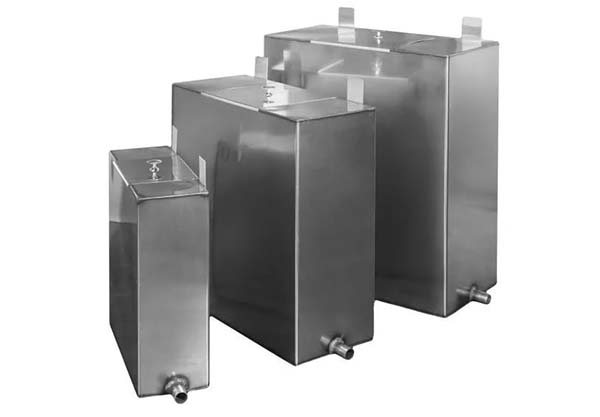
Calculation of the internal volume of the bath tank should be done in advance. This parameter is very important, since too much hot water is not always used. But too little leads to additional inconvenience - you have to constantly add water to the tank.
Calculating the volume of the tank is very simple: no more than 10 liters of water are required per person. It is enough to multiply the number of people who will constantly visit the bathhouse by the number of liters, and, as a reserve, add 15-20 liters. The resulting figure will become the volume of the bath tank. Modern models have a large difference in the internal volumes of containers; choosing the most suitable device is not difficult.
